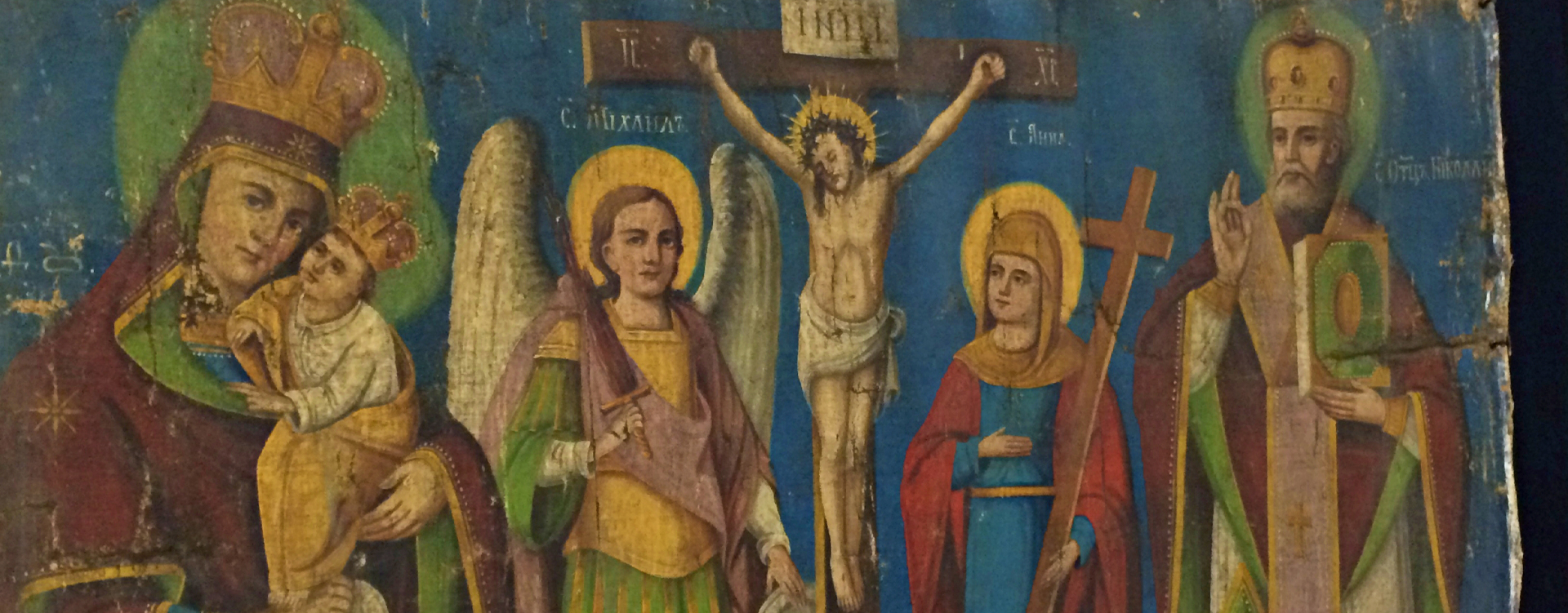-
Ternopil Canvas Icon
This outstanding piece-de-resistance is a large canvas Icon made in 1892 in the Ternopil region. It was buried for decades after WW2 to protect it from the Soviet authorities. It was owned by Doris Yanda and it is assumed that she acquired it on one of her trips to Ukraine (1960s to 1980s).
According to Icon expert, Father Andriy Chirovsky, the icon is an oil painting, created anonymously. All lettering on the icon is in Cyrillic, but it is painted in a Western, not Byzantine, style. Roman influence is apparent in the faces of individuals and by the crowns on the heads of Mary and Baby Jesus. The 1892 date is consistent with the general trend in the late 19th and early 20th centuries for icons in Eastern Europe to be painted in Roman or Western rather than Byzantine style. There is no indication whether the icon represented Ukrainian Greek Orthodoxy or Ukrainian Greek Catholicism.
The appearance of so many Holy Figures on one icon is a bit peculiar. It includes the Mother of God holding the Infant Jesus on the far left, then the Archangel Michael, then Jesus on the cross in the center, then St. Anna, and finally St. Nicholas at the far right. St. Anna is the mother of Mary, and one of Archangel Michael’s roles is to lead souls to heaven (made possible by the death of Jesus on the cross), so an argument can be made as to why these saints are depicted along with Mary and Jesus. However, the inclusion of St. Nicholas is unusual in this context; he almost seems like a place holder, like the iconographer needed one more saint and he couldn’t think of anyone more appropriate.
The icon was probably painted by a local artist for a church in a village or small town. The figures in it very likely represented local people of the village or town.
The icon probably was in a frame and rolled onto a dowling. It seems to have been stored under quite adverse conditions suggested by the poor state of the underside of the canvas. The Bolsheviks destroyed many churches and their contents. Therefore, the villagers removed many artifacts and hid them, often burying them.
-
Bishop’s Mitre and Sick Call Set
The bishop’s mitre was owned by Right Reverend Protopresbyter Ostap Flak. The golden metal container that almost looks like a pocket tabernacle with a miniature chalice is a Liturgical Sick Call Set for officiating Last Rites to sick people near death.
The mitre and the Sick Call Set lie on top of a relatively modern woven Kyivan Polissian style rushnyk. It was possibly woven in the famous Krolevets weaving factory in northern Sumy province, since northern Kyiv province has not had its own weaving factory now for several decades.
-
Chalice, Paten & Covers
The aer is the largest and outermost veil covering the chalice and diskos (paten).
The aer takes its name from the fact that the priest holds it in the air and waves it slowly over the chalice and diskos during the Nicene Creed at Divine Liturgy.
-
Vestment – Epigonation
The Epigonation is a stiff diamond-shaped cloth that hangs on the right side of the body below the waist, suspended by one corner from a strap drawn over the left shoulder. This is part of a vestment set of the late Rev. Michael Yurkiwsky, who served at St. Andrew’s in Edmonton, as well as various parishes in Saskatchewan, Manitoba and Ontario. The Epigonation or Palitza is worn by all bishops, and as an ecclesiastical award for some priests. It is considered to symbolise the “sword of the Spirit, which is the Word of God” (Ephesians 6:17); that is to say, the wearer’s defending of the faith by smiting all that is impure and vicious.
-
Icon from Ispas
This icon is from Ispas, Vyzhnytsky district, Chernivetska oblast, Ukraine.
-
Double Icon
This golden double icon was donated by the Luchak family. Right Reverend Protopresbyter Dmytro Luchak served parishes in Willingdon, Oshawa, Edmonton and Winnipeg.



